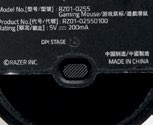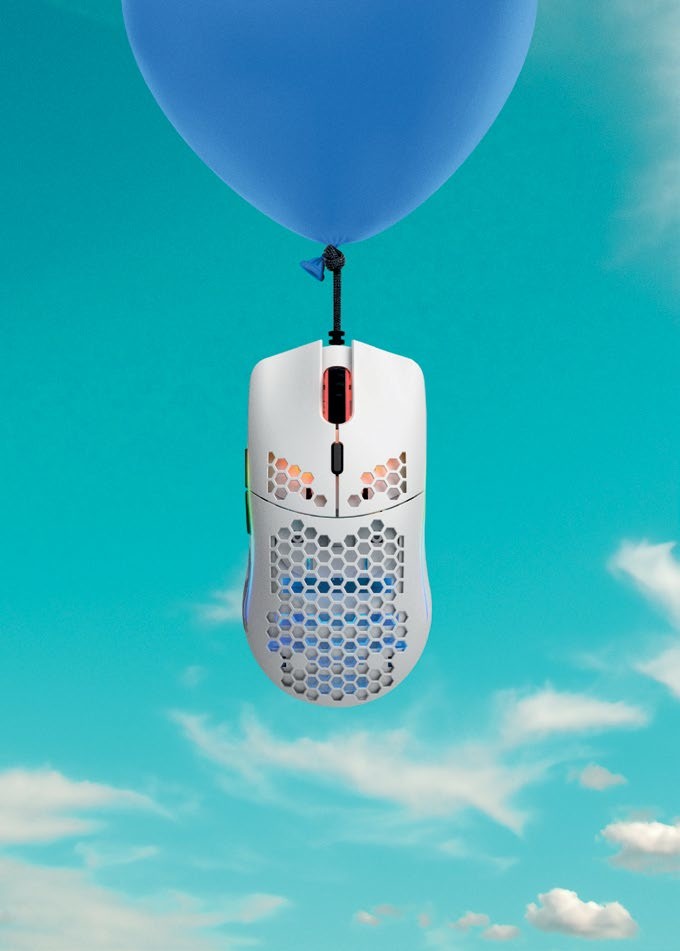Gaming mice are in a race toward rock bottom. Well, in terms of weight anyway.


Gaming mice are in a race toward rock bottom. Well, in terms of weight anyway.

FINALMOUSE AIR58 NINJA
At a sprightly 58g, this is one of the lightest gaming mice you can buy today. In fact, I can’t think of a lighter mouse now from any of the major players in the scene.The Cooler Master MM710 will weigh 52g, but that hasn’t been launched yet.
I know some people prefer heavier mice because they feel it helps them steady their aim, even adding weights in mice that come with them, so you should look elsewhere if you fall into that camp. Still, I cannot overstate how good a mouse this light is. It glides over your mousepad with ease and it feels gloriously agile and nimble. Having used the Logitech G Pro Wireless for a time as well – it’s really light in its own right at just 80g – I can also say that there’s a perceptible difference moving to the Air58 Ninja.
The shape of the mouse is also excellent, and it feels like it’ll work well with all grip styles. It does seem particularly suited for the palm grip though, thanks to its long and wide shape.
However, while the design might raise some concerns about comfort, the good news is that the perforated surfaces didn’t really bother me much at all. The mouse was no more difficult or uncomfortable to use than a regular mouse, and it was as if the holes were not there. Build quality also doesn’t seem to have been compromised much at all. I was admittedly worried about things like structural integrity and flexing, but there’s surprisingly no give to the sides of the mouse at all. There are no distracting creaks or flexing when you grip the mouse, and it feels really well put together.
The buttons feel good to use as well, and they don’t feel mushy and provide decent feedback. The scroll wheel works well enough, but it is on the lighter side and I do think the individual notches could have used slightly more definition.
A DPI toggle button sits below the scroll wheel, and it lets you cycle between steps of 400, 800, 1,600, and 3,200DPI. The Air58 Ninja has gone with a driverless operation, so you’re limited to these preset DPI stages and Finalmouse isn’t providing any software to change this. In addition, the mouse ships with a 500Hz polling rate and there’s unfortunately no way to increase it to 1,000Hz, save for a third-party software.
The Air58 Ninja is equipped with the PMW3360 optical sensor, the same as the Ultralight Pro from Finalmouse. It tracks flawlessly, with no discernible acceleration or smoothing. Furthermore, liftoff distance is really low as well, falling somewhere between 1-2mm. You won’t have any problems tracking with this mouse, and the only question will be whether you like its size and shape.
PROS
Lightweight design and comfortable shape
CONS
Limited to 500Hz polling rate

The paracord cable is wonderfully soft and flexible.

The scroll wheel features a unique, hand-painted haiku.

Even the bottom of the mouse is shot through with holes.

AT A GLANCE
SENSOR
3,200DPI PixArt PMW3360 optical sensor
DIMENSIONS
128 x 60 x 40mm
WEIGHT
58g
PRICE
US$89.99

GLORIOUS MODEL O
The Model O is basically what would happen if the Finalmouse Air58 and Zowie FK1 had a baby together. At 67g for the matte version (68g for the glossy), the Model O is 9g heavier than the Air58.
The reason for this is obvious – while the Air58 has perforated sides, the Model O has solid side grips where it stamped its branding.
However, much of the Model O’s success appears to stem from the fact that Glorious has cribbed the best ideas from various players and basically put them together into one mouse. As a result, the Model O is not particularly original or revolutionary, but it is a stunningly good mouse that may just shake up the gaming mouse market.
The similarities to the Air58 are unmistakable, with the same honeycomb shell and lightweight, flexible cable. However, given that the size and shape are nearly the same as the FK1, it’s also a bit flatter than the Air58, so you’ll like it if you prefer low-profile designs.
The Model O is equipped with four G-Skates mouse feet, and replacements are readily available to buy on their website. I have no complaints about the feet, and they glide smoothly over my cloth pad with no problems at all.
More importantly, build quality is excellent, and there doesn’t seem to be any issues despite the honeycomb shell. Even after pressing down on the sides and back of the mouse, there’s no discernible flexing or creaking. The honeycomb design exposes the internal circuit boards of the mouse though, so you don’t want to spill anything on it.
If you’re worried about dust build-up over the long-term, it seems like it might be easy enough to just get a blower to clean the mouse out, but I haven’t had the mouse for long enough to say how much of a problem this will eventually be.
The mouse buttons feel great, with nice, crisp feedback. Its rubberised scroll wheel also comes with deep grooves, which makes it easier to manipulate. This is an improvement over the haiku lettering on the Air58, which could also have used firmer and more well-defined steps. The Model O has no such issues, and I could clearly feel each individual notch when playing with the wheel.
Finally, the mouse also comes with built-in RGB lighting, which you can customise using Glorious’ software. You can also configure it with values between 400 and 12,000DPI. The software also lets you save up to six DPI stages, a big upgrade from the Air58 which has no drivers and limits you to 400, 800, 1,600, and 3,200DPI.
PROS
Excellent value for money
CONS
No independent lighting zones

AT A GLANCE
SENSOR
12,000DPI PixArt PMW3360 optical sensor
DIMENSIONS
128 x 59 x 37.5mm
WEIGHT
67g
PRICE
US$49.99

The PMW3360 optical sensor provides flawless tracking performance.

The Ascended Cord is super flexible with almost zero drag.

Glorious has stamped its logo on the right of the mouse.

RAZER VIPER
The Razer Viper is Razer’s lightest wired mouse to date, and it may be the first mouse from the company in a long while to really demonstrate a serious focus on professional gamers.
At 69g, the Viper is really super light, but its shell is blissfully solid; great news for trypophobia sufferers everywhere. In fact, it’s only 2g heavier than the Model O, a barely perceptible difference that I don’t think is humanly possible to discern. It’s managed that with a solid shell, which is pretty impressive, and it feels just as
agile and nimble in hand as the Model O. The mouse feels like just regular plastic though, and Razer didn’t specify if there was anything special about the material it used.
One of the biggest upgrades that Razer is touting on the Viper is the use of optical mouse switches, similar to what it did with the Huntsman Elite keyboard. Unlike traditional mechanical switches that rely on pieces of metal to make contact in order to register a click, the Viper’s switches rely on light. This means that there’s no need to implement any sort of debounce delay, resulting in actuation times that are, in theory, up to three times faster.
In practice, I can’t say that there’s actually a tangible difference. While I definitely think that optical switches are a nice step forward, they shouldn’t be the reason you buy this mouse. Buy the Viper because you like its design or shape, not because the switches will help you react faster.
Then there’s Razer’s new Speedflex cable, which comprises a low-drag cable covering that results in a cord that is more supple than the company’s existing braided cables. While the cords on the Air58 and Model O still feel slightly more flexible, the Speedflex cable is probably good enough for most people. At the very least, I didn’t feel much drag when making large, swiping movements.
The Viper uses the same 16,000DPI PixArt PMW3389 optical sensor as the Razer DeathAdder Elite. That sensor is pretty much regarded as flawless, which means no jitter, acceleration, or prediction. I was also unable to make the mouse spinout even when swiping really fast, so you shouldn’t have any issues with tracking on the mouse.
Razer’s mouse is also pretty similar to both the Model O and Zowie FK1. If you liked those mice, you’ll probably like the Viper. I’d describe it as long and kind of flat. There’s no prominent hump for you to cup, but I was still able to palm the mouse quite comfortably. My hands measure 16.5cm from the base of my palm to my fingertips, so the Viper is a little too large for me, but that’s no fault of the mouse. If you have larger hands, you should be able to use claw or fingertip grips with the mouse as well.
PROS
Super lightweight design with no holes
CONS
Mouse feet not the best

The mouse has side buttons on both sides for a truly ambidextrous design.

The textured rubber sides help provide a better grip.

The DPI button is at the bottom so you don’t hit it accidentally.

AT A GLANCE
SENSOR
16,000DPI PixArt PMW3389 optical sensor
DIMENSIONS
126.73 x 66.2 x 37.81mm
WEIGHT
69g
PRICE
US$79.99
SPECIFICATIONS


ULTRALIGHT MICE ARE COMING
Gaming mice today are lean, mean machines, and companies are only now just starting to push the envelope in terms of how light they can make their mice. The space is about to get increasingly crowded, including mice like the Final Mouse Air58 Ninja, the Glorious Model O (and soon to be released Model O-), the lesser known G-Wolves Skoll, and the upcoming Cooler Master MM710. On top of that, there’s also Xtrfy’s Project 4 mouse and a slightly absurd-looking carbon fiber mouse from German outfit Zaunkoenig. There’s even the Finalmouse Ultralight 2 now, which weighs a mere 47g.
AND THE BEST ULTRALIGHT GAMING MOUSE IS…

GLORIOUS MODEL O
The Glorious Model O wins almost entirely because of how affordable it is. All three mice here are remarkably similar, but the Model O beats both the Air58 and Viper when it comes to value. At just US$49.99, it offers a top-notch optical sensor, customisable RGB lighting, and a comfortable shape. Unlike the Air58, it also has its own software, so you get to enjoy further DPI customisations. There’s really little to dislike about the Model O, and it even boasts better stock mouse feet than the Viper and a super flexible cable that offers next to no drag. The Viper deserves praise because it manages to achieve its light weight with a solid shell, but there’s just no beating the price of the Model O.
Art Direction by Jason Tan























